| Home |
| Acknowledgments |
| Conventions |
| Glossary |
| Maps |
| References |
| Links |
| Articles |
| Thumbnails |
| Species
list |
| Family |
| Next
species |
Additional Photos

underside

front
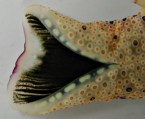
parapodia

dark
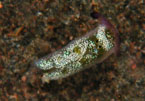
young

resting
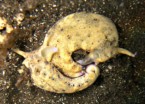
mating pair
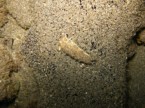
on cucumber

predation

with egg mass _______________
GALLERY

Plakobranchus ocellatus van Hasselt, 1824
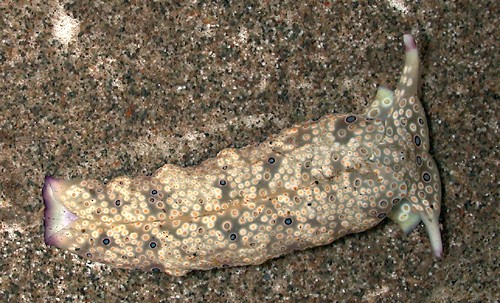
| Maximum size: about 64 mm
(Hoover, 2006). Identification: This species is distinctive in being dorso-ventrally flattened with broad parapodia that meet in the center of the notum and rhinophores that extend laterally. Its translucent, gray-cream body is decorated with yellow-centered and blue-centered ocelli and there are purple highlights on the rhinophore tips and posterior margin. Beneath the parapodia are longitudinal green ridges. Natural history: Plakobranchus ocellatus is the most commonly seen plakobranchid in sandy and mixed habitats from < 1 to 18 m (3-60 ft). It occurs in highly protected to moderately protected back reef areas and in Halimeda kanaloana beds at greater depths. Active crawling and mating are often crepuscular with the animals spending much of the time both by day and night resting passively on the bottom with a fine layer of sand covering their bodies (sometimes, in groups). They may retract their eye spots while resting. (Note 1) Chloroplasts derived from their food are retained in the ridges beneath their parapodia and may be providing much of their nutrition. (Note 2) The egg mass is a cream, irregular spiral with a ribbon diameter of about 1 mm. It is typically laid on algae such as Halimeda and Acanthophora. (Kay, 1979) (Note 3) Distribution: Big Island, Maui, Molokai, Oahu, Kauai, French Frigate Shoals, Midway and Kure: widely distributed in the Indo-Pacific. Taxonomic notes: This species was named for the blue and yellow centered ocelli that cover the body and it's referred to as the "ringed sap-sucking slug" in Hoover, 1998 & 2006. It was first reported from Hawaii in Gould, 1852 (as Placobranchus ianthobapsus) and is listed under that name in Ostergaard, 1955. Elysia ocellata Pease, 1860 and Placobranchus argus Bergh, 1872 are also synonyms. It's listed as Placobranchus sp. in Edmondson, 1946 and Ostergaard, 1950. The species will probably be split, at some point, per Krug, et. al., 2013 (though it's likely that there will only be one species in Hawaii). When that happens, the Hawaiian population will probably be named Placobranchus ianthobapsus Gould, 1852. Photo: CP: Airport Beach, Maui; June 21, 2005. Observations and comments: Note 1: Regarding the animal in this photo, Jenna Szerlag reported "When I approached this animal it was VERY still. I took a few photos of it with its eyes retracted and then when it started crawling its eye spots were back out again. Unfortunately, I did not see the moment they popped back out.." Note 2: Conceivably, the translucent tissue of the parapodia may be filtering or focusing sunlight in such a way as to optimize its spectrum or intensity for the retained chloroplasts (perhaps, in conjunction with the sand layer retained on the body surface?). Note 3: Many times we've seen this species resting on top of the sea cucumber, Holothuria whitmaei, at night. (see photos) However, the association may be coincidental since the cucumber covers itself with a thin layer of sand. |
| Thumbnails |
Species
list |
Family | Next species | Top |